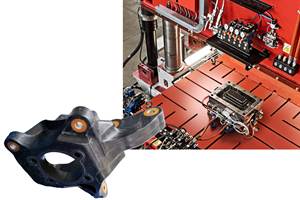Oil drives the Big Three
This is, in some ways, a tough time to be a U.S.-based automaker. Detroit’s traditional Big Three (GM, Chrysler, Ford) are struggling to keep up with Japan’s Big Three (Toyota, Honda, Nissan) and trying hard to develop cars and trucks that are good-looking, reliable and fuel-efficient. On top of this, rising oil
This is, in some ways, a tough time to be a U.S.-based automaker. Detroit’s traditional Big Three (GM, Chrysler, Ford) are struggling to keep up with Japan’s Big Three (Toyota, Honda, Nissan) and trying hard to develop cars and trucks that are good-looking, reliable and fuel-efficient. On top of this, rising oil prices, concerns about global warming and increased consumer eco-sensitivity are forcing all carmakers to develop and explore new technologies (the batteries that enable plug-in electric cars, fuel cells, hydrogen storage tanks and the like) that have high upfront cost but a long return on investment. Still, the effort at innovation is being made and change is afoot in automotive development. The question before us is this: Is the composites industry ready to be a part of this technology shift?
Things certainly looked promising as 2007 started. First out of the gate was the Tesla Roadster, the composites-intensive, all-electric sportscar that debuted in January last year. This was followed by the introduction of GM’s Volt, a plug-in gas/electric hybrid that, promisingly, used composite body panels in concept form, but sadly, from what we hear, is headed into production sans composites panels. Then, this month, at the North American International Auto Show (NAIAS) in Detroit, Mich., came Fisker Automotive’s Karma, an $80,000 plug-in gas/electric hybrid that should be available to consumers by 2009. Designed to run 50 miles on a single charge, the Karma would be a prime candidate for composites. Alas, it’s aluminum-intensive.
While all this was happening, the U.S. Congress responded to oil’s scarcity and increasing cost by passing new corporate average fuel economy (CAFE) standards as part of the 2007 energy bill that was signed into law in mid-December. On paper, the new CAFE standards seem reasonable: by 2020, the fleet of cars and light trucks fielded by each carmaker must average 35 mpg. Automakers, however, claim that the CAFE standards impose artificial and sometimes unattainable goals on the industry and handcuff them when it comes to responding to consumer demand.
For the time being, however, consumer demand and CAFE standards are congruent: we drivers, tired of paying $50 to fill our gas tanks, are demanding efficient, eco-friendly, safe, sleek and sometimes fast cars.
Each of these demands should be driving automakers toward greater use of composites: When it comes to strength-to-weight ratios, styling freedom and the potential for parts consolidation, composites are impossible to beat. Their biggest hurdle — and it is a high one — is production cycle time for large composites parts, such as body panels. The goal, we keep hearing, is a sub-two-minute cycle time for a composites molding process using an affordable material. And we don’t have it yet. SMC is promising but offers relatively modest weight savings given wall thicknesses required. Carbon fiber prepreg as a material is ideal but too expensive and requires autoclave cure. Reinforced thermoplastics have made huge strides in recent years and meet the affordability requirement, but cycle times are still too long. The automotive composites industry, therefore, needs two things: A proven, fast manufacturing process using an affordable material, and an automaker willing to take the risk of embracing it. The former seems a likely, if slow-developing, prospect given past and ongoing technological advancements in composites. The forthcoming Corvette ZR1 is emblematic of this potential, but primarily in low-volume, more expensive vehicles (click on “NAIA Show Highlights,” under “Related Content,” at left). The latter, a risk-taking automaker, might be harder to find, but one has to hope that the built-in value of composites will help the material sell itself. Ultimately, though, the automotive composites industry will have to pull together to collectively, aggressively, assertively and positively sell itself to become a major player in the rapidly changing automotive world. What is known for sure is that the window of opportunity is open now as it never has been before.
Related Content
SMCCreate 2023 invites attendees, presentation speakers
The SMC/BMC-focused event will take place from Nov. 7-8 in Prague, targeting experienced designers and those that may be new to applying SMC/BMC materials.
Read MoreA digital twin to validate SMC performance in suspension structures
High-fidelity, anisotropic behavior material card, integrated with process simulation, structural FEA and validated with CT and physical tests enables optimization proven in award-winning SMC suspension knuckle.
Read MoreMaterials & Processes: Fabrication methods
There are numerous methods for fabricating composite components. Selection of a method for a particular part, therefore, will depend on the materials, the part design and end-use or application. Here's a guide to selection.
Read MoreComposite resins price change report
CW’s running summary of resin price change announcements from major material suppliers that serve the composites manufacturing industry.
Read MoreRead Next
CW’s 2024 Top Shops survey offers new approach to benchmarking
Respondents that complete the survey by April 30, 2024, have the chance to be recognized as an honoree.
Read MoreComposites end markets: Energy (2024)
Composites are used widely in oil/gas, wind and other renewable energy applications. Despite market challenges, growth potential and innovation for composites continue.
Read MoreFrom the CW Archives: The tale of the thermoplastic cryotank
In 2006, guest columnist Bob Hartunian related the story of his efforts two decades prior, while at McDonnell Douglas, to develop a thermoplastic composite crytank for hydrogen storage. He learned a lot of lessons.
Read More






















